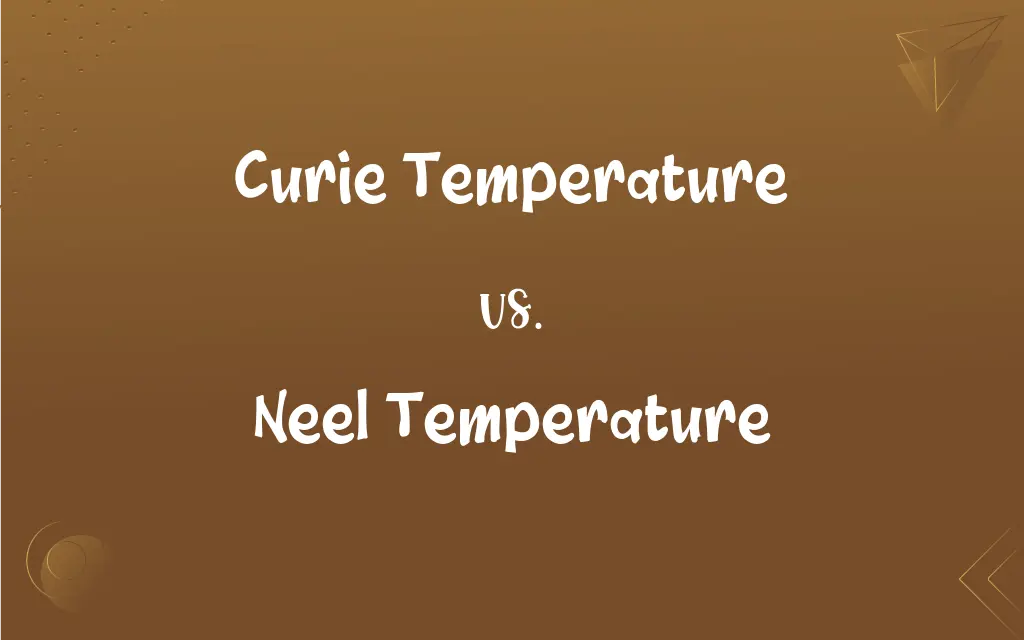Curie Temperature vs. Neel Temperature: What's the Difference?
Edited by Harlon Moss || By Janet White || Published on February 1, 2024
Curie temperature is the point at which a ferromagnetic material becomes paramagnetic, while Néel temperature is the temperature at which an antiferromagnetic material becomes paramagnetic.

Key Differences
Curie temperature, named after Pierre Curie, is the critical point where ferromagnetic materials lose their magnetic ordering and become paramagnetic. Néel temperature, named after Louis Néel, refers to the temperature at which antiferromagnetic materials transition to a paramagnetic state.
In ferromagnetic materials, Curie temperature marks the loss of spontaneous magnetization due to thermal agitation. In contrast, Néel temperature signifies the temperature at which the opposing spins in an antiferromagnetic material become disordered.
The Curie temperature is a fundamental property of ferromagnetic substances like iron, cobalt, and nickel. The Néel temperature is characteristic of antiferromagnetic materials such as manganese oxide.
Above the Curie temperature, a ferromagnetic material can no longer hold a permanent magnetization. Above the Néel temperature, antiferromagnetic materials lose their antiparallel spin arrangement.
The exact value of the Curie temperature varies depending on the material's composition and structure. Similarly, the Néel temperature is influenced by factors like crystal structure and magnetic ion concentration.
ADVERTISEMENT
Comparison Chart
Material Type
Ferromagnetic materials
Antiferromagnetic materials
Magnetic Transition
To paramagnetic state
To paramagnetic state
Effect on Magnetization
Loss of spontaneous magnetization
Disordering of antiparallel spins
Example Materials
Iron, Cobalt, Nickel
Manganese Oxide, Iron Oxide
Influencing Factors
Material composition, structure
Crystal structure, magnetic ion concentration
ADVERTISEMENT
Curie Temperature and Neel Temperature Definitions
Curie Temperature
Curie temperature is the point where ferromagnetic materials become paramagnetic.
Iron loses its ferromagnetic properties above its Curie temperature of around 770°C.
Neel Temperature
Néel temperature is crucial in understanding antiferromagnetic behavior.
Studying the Néel temperature helps in exploring antiferromagnetic properties.
Curie Temperature
Curie temperature varies with the type of ferromagnetic material.
Nickel has a lower Curie temperature compared to iron.
Neel Temperature
Néel temperature depends on the material's crystal structure.
Changes in crystal structure can significantly affect the Néel temperature.
Curie Temperature
Curie temperature is critical in applications like magnetic data storage.
Data storage devices must operate below the Curie temperature to maintain magnetization.
Neel Temperature
Néel temperature is where antiferromagnetic materials transition to paramagnetism.
Manganese oxide becomes paramagnetic above its Néel temperature.
Curie Temperature
Curie temperature marks the loss of permanent magnetization in ferromagnets.
The magnet no longer stayed magnetized after reaching the Curie temperature.
Neel Temperature
Néel temperature signifies the disordering of spins in antiferromagnets.
Above the Néel temperature, the antiparallel spin alignment in the material gets disrupted.
Curie Temperature
Curie temperature is influenced by external factors like pressure.
Applying pressure can alter the Curie temperature of some ferromagnets.
Neel Temperature
Néel temperature is specific to antiferromagnetic substances.
Different antiferromagnetic materials have distinct Néel temperatures.
FAQs
What does the Néel temperature indicate?
It indicates the temperature at which an antiferromagnetic material becomes paramagnetic.
Why is Curie temperature important in ferromagnets?
It's important because it defines the upper temperature limit for a material's ferromagnetic properties.
How is Curie temperature measured?
It's measured by observing the point at which the material loses its spontaneous magnetization.
What materials typically have a Néel temperature?
Materials like manganese oxide and iron oxide, which are antiferromagnetic.
Does Néel temperature depend on external factors?
Yes, factors like pressure and crystal structure can affect it.
What happens at the Néel temperature in antiferromagnets?
The orderly antiparallel spin arrangement becomes disordered.
Can Curie temperature vary?
Yes, it varies based on the material's composition and structure.
How does pressure affect Curie temperature?
Increased pressure can increase or decrease the Curie temperature, depending on the material.
Is Curie temperature relevant in everyday technologies?
Yes, it's relevant in technologies like magnetic storage and electric motors.
What is the Curie temperature?
It's the temperature at which a ferromagnetic material becomes paramagnetic.
What is an example of a material with a high Curie temperature?
Iron, with a Curie temperature of around 770°C.
Are there applications reliant on Néel temperature?
Yes, in magnetic recording and spintronic devices.
What role does Néel temperature play in scientific research?
It's crucial in studying magnetic properties and transitions in antiferromagnetic materials.
Are there health or safety concerns related to Curie temperature?
Not directly, but handling materials at high temperatures requires safety precautions.
Does the structure of a material influence its Néel temperature?
Yes, crystal structure and magnetic ion concentration significantly influence it.
Can Curie temperature be altered artificially?
It can be influenced by doping or altering the material's composition.
What does a high Néel temperature signify?
It signifies strong antiferromagnetic interactions within the material.
Is Curie temperature a fixed property?
While intrinsic to the material, it can be affected by factors like alloying and structural changes.
How does Néel temperature affect magnetic susceptibility?
Magnetic susceptibility typically drops sharply at the Néel temperature.
Can the Néel temperature be predicted theoretically?
Yes, through models and calculations based on the material's magnetic properties and interactions.
About Author
Written by
Janet WhiteJanet White has been an esteemed writer and blogger for Difference Wiki. Holding a Master's degree in Science and Medical Journalism from the prestigious Boston University, she has consistently demonstrated her expertise and passion for her field. When she's not immersed in her work, Janet relishes her time exercising, delving into a good book, and cherishing moments with friends and family.
Edited by
Harlon MossHarlon is a seasoned quality moderator and accomplished content writer for Difference Wiki. An alumnus of the prestigious University of California, he earned his degree in Computer Science. Leveraging his academic background, Harlon brings a meticulous and informed perspective to his work, ensuring content accuracy and excellence.






































































